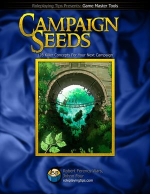Stephan Hornick
Community Goblin & Master of the Archive
Platinum WoA
Wizard of Story
Wizard of Combat
Borderland Explorer

Left Hooks: 24 Plot Twist Ideas & Design Patterns
By JohnnFour | Updated May 24, 2021Roleplaying Tips Newsletter #617

Plot twist ideas are hard to think up. So, as I reviewed all the seeds when producing the Campaign Seeds: From Zero to Killer Campaign Concept book, I paid particular attention to the Left Hook plot twist idea section of each seed. There are some excellent twists in the book!
And while reading, I noticed several patterns emerge and took a bunch of notes.
The patterns self-grouped into several twist types, which I’m calling Campaign Twist Design Patterns.
In this article, I share all 24 design patterns I noticed with you. Use them as templates to create your own plot twist ideas and layer cool surprises into your campaigns and adventures.
If you have more twist ideas or links, please send them in and I’ll expand this list!
24 Plot Twist Ideas & Design Patterns
1. Clues Of A Spy
“The PCs will encounter any of the magic items they sold.”This is my favourite twist on this list. It involves an informant spying on the PCs and then blowing their cover because of evidence the players can figure out and follow the crumbs back to their source.
It’s a mini plot thread all on its own and you can drop it into almost any situation.
For example, merchants who serve the PCs make great spies. They can ask about the PCs’ adventure to seemingly make conversation. They can pretend to be impressed and appeal to character (and player) egos to pump them for more information.
Bartenders and waitresses, traders in magic and special equipment, craftsmen, sages, smiths – anyone the PCs go to on their own to trade with. And because the characters seek these merchants out, their guards will be down and they’ll reveal information useful to villains, information brokers, and gossips.
Imagine the characters coming back to town to rest up, arms full of loot. After getting chatted up, the next day they find several adventuring parties following the PCs’ tracks back to the adventure site!
Another example – the characters sell off a bunch of unwanted magic items and then later on encounter foes wielding them. The players have to fight their own treasure!
I suppose this works to the group’s advantage, as they might recognize and possibly know special properties of the items being used against them. And if they win, they get to sell the items a second time. And if they return to the same merchant, they might try to rob him, knowing the bad guys just purchased the items and the merchant probably has that money hidden around somewhere close.
But a merchant is likely to have figured this trick out, either from the hard way or because they’re smart. So they’ll have some kind of defense ready, such as a protection agreement from the thieves’ guild, villain, or some other strong faction.
Man, this twist just keeps giving and giving!
2. Damned If You Do, Damned If You Don’t
In this twist, each PC victory actually benefits the villain in the long run.First, create the game piece the players need to defeat.
Then add an economy – figure out how each defeat adds points to a big game piece.
Last, add a tipping point. When the pool reaches a certain level or amount, the game changes in some way that makes the PCs’ job more difficult.
For example, and this is a spoiler for Chaos Keep so skip to the next twist design pattern if you don’t want to learn a secret about the adventure I’m making….
….In the game’s world the PCs will explore, demons and devils feed on souls. Each time the PCs defeat a fiendish servant, that servant’s soul feeds the one who was its master. This is like XP for the master, and in this way it gets more powerful each time it “levels up” after gaining enough soul XP.
This creates an interesting dynamic, where fiendish masters want to put more minions into play. If the minions defeat good, the masters win. If the minions die at the hand of good, the master win.
It should be a great challenge for the PCs and a fun dilemma for the adventure!
3. Ally With Enemy
“Out of nowhere, a fleet from the upper Ocean attacks the town. Can the PCs recruit Red Havoc and his pirate fleet to defend the town?”The PCs start the campaign fighting a particular foe. Then a new and bigger danger appears.
Can the players put aside their hatred and team up?
Or will the new foe be able to divide and conquer for the win?
4. Traitor
An NPC apparently serving one faction secretly serves another.This is a classic twist. Your job is to play up and sell the NPC’s unquestioning loyalty so it catches players off-guard when the traitor is revealed.
For example, the party spots a farmstead burning in the distance. They rush to help and find children caught in the cellar underneath the burning building. Meantime, the departing raiders spot the PCs and rush back to attack.
After both threats have been dealt with, the players are left to figure out what to do with the kids. They’ve also captured a raider and interrogate him. They learn about a stage boss in the area and decide to counter-attack.
Along the way it seems like the party keeps falling into the stage boss’s hands. No matter how much they interrogate their prisoner, who must be communicating with the enemy somehow, the party can’t figure it out. They also spend time searching for trackers and scouts who might be observing from a distance, but no luck.
At last, the PCs arrive battered and limping at the stage boss’s base. He’s out front, with his toughest minions, to confront and slay the PCs. As the party prepares for battle the children run away, toward the bad guy, yelling “Daddy!” as he waits with open arms to be finally reunited with his family….
5. Remove A Game Limitation
Surprise players with a foe who does not have the usual flaws.Do this by looking for rules that limit the foe. Then remove or change the rule.
If your foes don’t have limits, then start adding flaws and hindrances to all the game pieces starting now. Not only does this make your games unique and interesting, but it sets you up to execute this left hook.
For example, some undead cannot survive sunlight. The party knows this and uses it to their advantage at the beginning of the campaign. Then they meet the villain’s lieutenant, but he seems like a regular guy just having a drink at the tavern at noon. He comments how hot it is outside.
When the PCs finish their business with their mugs of ale, rumour gathering, and catching up with the dark stranger in the corner, they leave. But they are ambushed in the street by the undead lieutenant and his minions. In broad daylight.
Another example would be to make a race of monsters governed by different factions. Each faction is tougher than the previous, and each is susceptible to a particular type of poison. Figure out the poison the hill ratmen fall to, and it won’t be as effective on the mountain ratmen, for example. Then the PCs encounter the storm ratmen, but they are immune to poison – all poison.
While the PCs try to figure out what type of poison will take the storm ratmen down, the creatures use this diversion to launch an attack elsewhere, where the PCs have just adventured and abandoned because there’s no gold left.
6. Taint, Corruption & Insanity
“When frost wraiths kill someone, that person is raised as a new frost wraith. The more frost wraiths in an area, the more the temperature drops. Once an area gets to be freezing or below, the temperature will remain frozen until Hoarfrost himself is defeated.”Some kind of accumulation effect weakens and threatens the PCs in the end.
Cthulhu has an insanity effect, as does the Barrowmaze mega-modules.
You might use corruption instead of alignment.
Or try some flavour of taint as the PCs get exposed to an ancient evil.
The best left hook affects the PCs personally, such as something that affects a stat or score.
For example, the party’s cleric follows a god of good. Each time a PC does something blatantly evil, they get an Evil Taint point. Grab a small container for them and put a bead in it whenever an evil deed is done. When characters get healing from the cleric, they’re healed whatever the cleric’s spell does minus their current Evil Taint score. An impressive and heroic good deed will remove one Taint Point.


